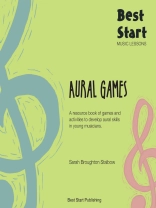Ongoing development of aural skills is a fundamental aspect of music education. These are the skills a student needs to be able to keep a steady pulse and play in time with a strong sense of rhythm. Well developed aural skills also allow students to be able to:
• assess their own sound,
• self correct, and
• play in tune.
This book is intended to be used in conjunction with beginner instrumental music lessons, to develop aural skills and awareness as a regular part of each lesson. The activities are designed to be completed with a teacher during lessons and are suitable for both individual and group contexts. They are short and require very little pre-planning or organization, making them ideal for instrumental teachers to select quickly and as needed, during lessons.
The activities can be implemented without the need for props or additional percussion instruments, although if available, these can be used in some activities to add interest and variety. Teachers may wish to select aural activities to be used in conjunction with the introduction of specific concepts in instrumental lessons. The colour illustrations included in the book are for the benefit of the students. The teacher may use the visual images to help students comprehend the musical characteristics of the aural activities.
Teachers may choose to allocate five minutes of each lesson to an aural activity from this book. Teacher and student can take tuns to choose which activity to do, alternating each week. Giving the student a choice (albeit on alternate weeks), allows the student to have some power and control over what they are doing, and this encourages autonomy.
Many activities mirror the aural test requirements in AMEB*, ABRSM** and Trinity College London music exams, thus providing preparation resources for students approaching their first music examinations. Regular exposure and practise of aural skills promotes students’ musical development in so many ways, yet often these skills are neglected until just before a music exam!
There are many excellent references and resources available on the development of children’s aural skills, particularly from the Kodaly associations. Also, there are many classroom music teachers who have developed excellent resources for aural development, particularly in using singing and movement to teach musical concepts. The activities in this book are also suitable for classroom music lessons or can be adapted with minimal effort, for the classroom context.
Further information and resources are available from the following organisations:
• International Kodaly Society: https://www.iks.hu/
• Kodaly Music Education Institute of Australia: http://www.kodaly.org.au/resources
• Dalcroze Australia: https://www.dalcroze.org.au/
* Australian Music Examinations Board
** Associated Board of the Royal Schools of Music
Cuprins
Developing Inner Hearing Page 8
1. Heartbeat Call and Response
2. Silent Beats
3. Silent Heartbeat
4. Mary #1
5. Mary #2
6. Mary #3
7. Stop and Go
Music and Movement Page 11
1. In the hall of the Mountain King
2. Dance of the Sugar Plum Fairy
3. Hedwig’s Theme
4. O Fortuna
5. Danse Macabre
6. Rodeo
7. Waltz No.2
8. Syncopation
9. The Can Can
Pulse and Rhythm Page 16
1. Call and Response Rhythms
2. Tempo (Speed) Change
3. Keep the Beat
4. Follow the Leader
5. Expressive Pulse
6. Partner Clapping
7. Miss Mary Mack
8. Sevens
9. Name Game
10. Feet and Hands #1
11. Feet and Hands #2
12. Feet and Hands #3
Solfege Singing Page 22
1. First Intervals
2. Advanced Intervals
3. Fixed Doh – Copycats
4. Copycats – Leaving Out Notes
5. Hot Cross Buns – Moveable Doh
6. Twinkle Twinkle – Moveable Doh
7. Doh Mi Soh
8. Compose
Listening Skills Page 30
1. High / Low
2. Jumping / Stepping
3. Major/minor – Happy/sad
4. Triple or Duple?
5. Listen – Clap – Sing
6. Step up or Down?
7. Step or Skip?
8. Echo Game
9. Song Detective
10. Scale Singing
11. Scale Detective
12. Chord Singing #1
13. Chord Singing #2
14. Part Singing
15. Expression Detective
Despre autor
Sarah Broughton Stalbow is a well known flute player and educator from Sydney, Australia. She is a graduate of the Royal College of Music, London, and the Australian National University, Canberra School of Music. Sarah has performed in orchestras in the United Kingdom, China, and Australia, and as a chamber musician she has toured Asia.
Sarah has a special interest in teaching beginners, and has been inspired by her mother, specialist in childhood development and learning, Beverley Broughton.












